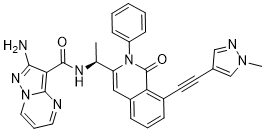| Cas No.: | 1693758-51-8 |
| Chemical Name: | Eganelisib |
| Synonyms: | IPI549;IPI-549;IPI-549(IPI549);BCP18992;2-amino-N-[(1S)-1-[8-[2-(1-methylpyrazol-4-yl)ethynyl]-1-oxo-2-phenylisoquinolin-3-yl]ethyl]pyrazolo[1,5-a]pyrimidine-3-carboxamide;AK676292;2-Amino-N-[1-[8-[2-(1-methylpyrazol-4-yl)ethynyl]-1-oxo-2-phenylisoquinolin-3-yl]ethyl]pyrazolo[1,5-;Eganelisib |
| SMILES: | O=C1C2C(C#CC3C=NN(C)C=3)=CC=CC=2C=C(C(C)NC(C2C(N)=NN3C=CC=NC3=2)=O)N1C1C=CC=CC=1 |
| Formula: | C30H24N8O2 |
| M.Wt: | 528.5640 |
| Purity: | >98% |
| Sotrage: | 2 years -20°C Powder, 2 weeks 4°C in DMSO, 6 months -80°C in DMSO |
| Description: | IPI549 is a potent and selective PI3Kγ inhibitor with an IC50 of 16 nM. |
| In Vivo: | IPI-549 demonstrates favorable pharmacokinetic properties and robust inhibition of PI3K-γ mediated neutrophil migration. In vivo (mice, rats, dog, and monkeys), IPI-549 has excellent oral bioavailability, low clearance, and distributed into tissues with a mean volume of distribution of 1.2 L/kg. Overall, IPI-549 has a favorable pharmacokinetic profile to allow potent and selective inhibition of PI3K-γ in vivo. The t1/2 of IPI-549 for mouse, rat, dog and monkey is 3.2, 4.4, 6.7 and 4.3 h, respectively. IPI-549 significantly reduces neutrophil migration in a dose dependent manner in this model when administered orally at all of the tested doses[1]. |
| In Vitro: | IPI-549 inhibits PI3Kγ with IC50 of 16 nM, with >100-fold selectivity over other lipid and protein kinases (PI3Kα IC50=3.2 μM, PI3Kβ IC50=3.5 μM, PI3Kδ IC50>8.4 μM). IPI549 is evaluated for activity across all Class I PI3K isoforms. The binding affinity of IPI549 for PI3K-γ is determined by measuring the individual rates constants and for PI3K-α, β and δ using equilibrium fluorescent titration. IPI549 is found to be a remarkably tight binder to PI3Kγ with a Kd of 290 pM and >58-fold weaker affinity for other Class I PI3K isoforms (PI3Kα Kd=17 nM, PI3Kβ Kd=82 nM, PI3Kδ Kd=23 M). In PI3K-α, -β, -γ, and -δ dependent cellular phospho-AKT assays, IPI549 demonstrates excellent PI3K-γ potency (IC50=1.2 nM) and selectivity against other Class I PI3K isoforms (>146-fold). Cellular IC50s for Class I PI3Kα (250 nM), PI3Kβ (240 nM), PI3Kγ (1.2 nM), PI3Kδ (180 nM) are determined in SKOV-3, 786-O, RAW 264.7, and RAJI cells, respectively, by monitoring inhibition of pAKT S473 by ELISA. Furthermore, IPI549 dose dependently inhibits PI3Kγ dependent bone marrow-derived macrophage (BMDM) migration. IPI549 is also found to be selective against a panel of 80 GPCRs, ion channels, and transporters at 10 μM[1]. |

 To enhance service speed and avoid tariff delays, we've opened a US warehouse. All US orders ship directly from our US facility.
To enhance service speed and avoid tariff delays, we've opened a US warehouse. All US orders ship directly from our US facility.




















